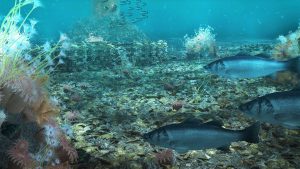Van Oord in Pilot Project Oyster Recovery
 Together with the North Sea Foundation and the Natuur & Milieu organisation, Van Oord and Eneco are starting a unique oyster recovery project to restore natural underwater features around windfarms: ‘the Rich North Sea’.
Together with the North Sea Foundation and the Natuur & Milieu organisation, Van Oord and Eneco are starting a unique oyster recovery project to restore natural underwater features around windfarms: ‘the Rich North Sea’.
A pilot project at Eneco’s Luchterduinen windfarm will investigate how nature conservation and sustainable energy generation can reinforce one another.
The demonstration project will provide know-how and possibly a blueprint for underwater nature restoration at all offshore windfarms, so that this can soon become standard when constructing new wind projects. Numerous big new windfarms are planned for the Dutch sector of the North Sea in the coming years. With the new project, Van Oord, Eneco, Natuur & Milieu, and the North Sea Foundation aim to show that nature conservation and sustainable energy generation can be mutually beneficial. In addition to this project, Van Oord is also preparing an oyster project at the Borssele V innovation site. This will increase our understanding of how to speed up the recovery of oysters in the North Sea, something that is very important for improving biodiversity. Use of trawl nets is prohibited within windfarms, and marine life can attach to the support towers. This makes windfarms the ideal location for proactively reinforcing natural underwater features. Various types of artificial reef systems and oysters will be positioned within the windfarm. The oysters will produce larvae that contribute to the creation of a full-scale reef that then attracts all kinds of other species, such as crabs, fish, and seals.
Human intervention and diseases have led to the virtually complete disappearance of natural reefs, often shellfish beds, from the North Sea. Reefs play an important role underwater, filtering water and acting as an attachment point and source of food. During the pilot project, the organisations will investigate the optimum underwater conditions to enable nature to thrive once again. The know-how gained will go towards drawing up a blueprint that can be applied to future windfarms. The reef structures will be positioned within Eneco’s Luchterduinen windfarm this coming autumn using a Van Oord installation vessel. The artificial reefs will consist of reef balls and cages containing adult oysters. These will produce larvae that will then contribute to the creation of a full-scale reef with all kinds of other species – a veritable nursery for biodiversity. How nature develops within the pilot project will be tracked in a scientific research and monitoring programme in collaboration with Waardenburg consultants and Wageningen University and Research Centre.






